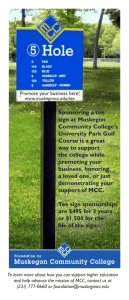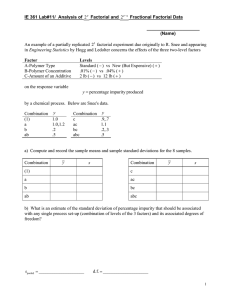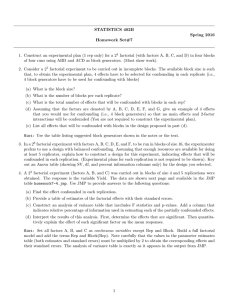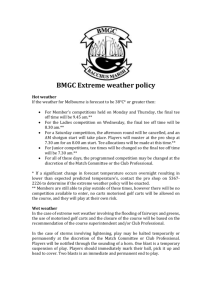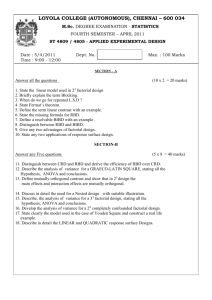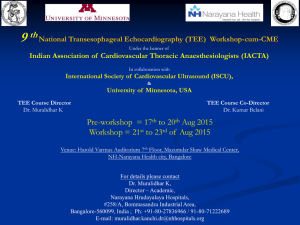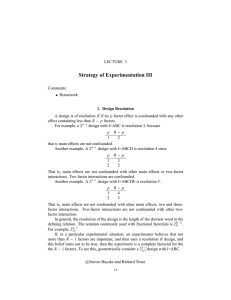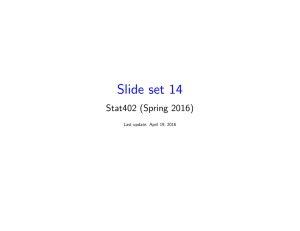STATISTICS 402B
advertisement
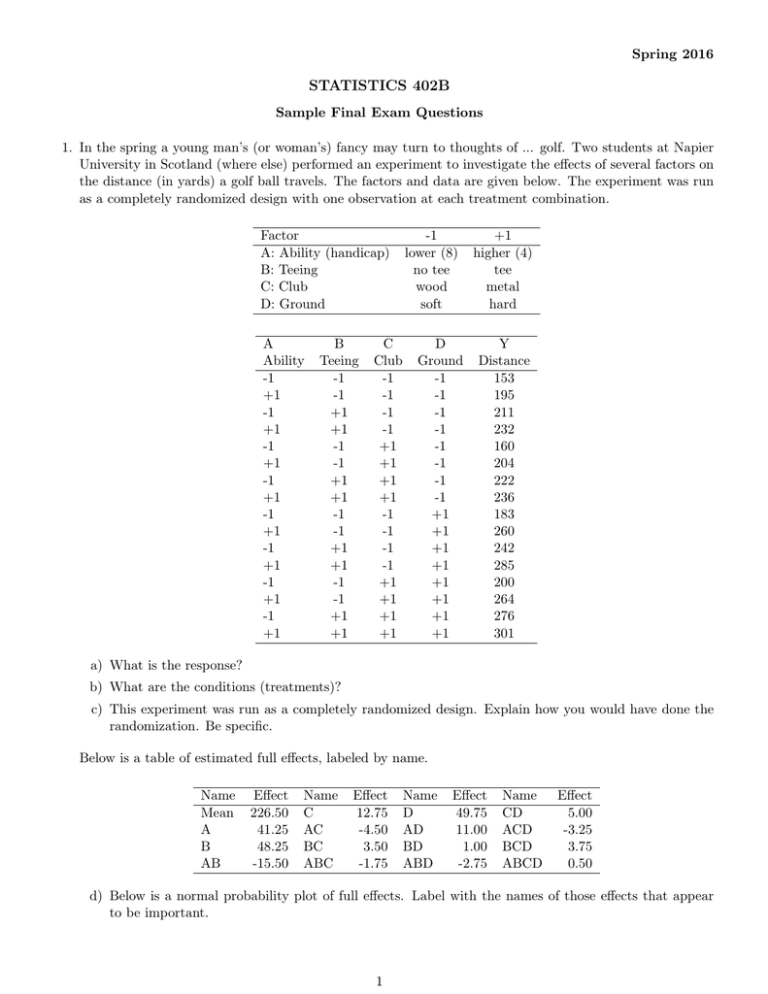
Spring 2016 STATISTICS 402B Sample Final Exam Questions 1. In the spring a young man’s (or woman’s) fancy may turn to thoughts of ... golf. Two students at Napier University in Scotland (where else) performed an experiment to investigate the effects of several factors on the distance (in yards) a golf ball travels. The factors and data are given below. The experiment was run as a completely randomized design with one observation at each treatment combination. Factor A: Ability (handicap) B: Teeing C: Club D: Ground A Ability -1 +1 -1 +1 -1 +1 -1 +1 -1 +1 -1 +1 -1 +1 -1 +1 B Teeing -1 -1 +1 +1 -1 -1 +1 +1 -1 -1 +1 +1 -1 -1 +1 +1 C Club -1 -1 -1 -1 +1 +1 +1 +1 -1 -1 -1 -1 +1 +1 +1 +1 -1 lower (8) no tee wood soft D Ground -1 -1 -1 -1 -1 -1 -1 -1 +1 +1 +1 +1 +1 +1 +1 +1 +1 higher (4) tee metal hard Y Distance 153 195 211 232 160 204 222 236 183 260 242 285 200 264 276 301 a) What is the response? b) What are the conditions (treatments)? c) This experiment was run as a completely randomized design. Explain how you would have done the randomization. Be specific. Below is a table of estimated full effects, labeled by name. Name Mean A B AB Effect 226.50 41.25 48.25 -15.50 Name C AC BC ABC Effect 12.75 -4.50 3.50 -1.75 Name D AD BD ABD Effect 49.75 11.00 1.00 -2.75 Name CD ACD BCD ABCD Effect 5.00 -3.25 3.75 0.50 d) Below is a normal probability plot of full effects. Label with the names of those effects that appear to be important. 1 Bivariate Fit of Estimate By z-score 30 25 20 15 10 5 0 -5 -10 -2 -1.5 -1 -0.5 0 0.5 1 1.5 2 z-score Linear Fit e) Are there factor(s) that can be dropped? If so, which ones? Explain briefly. f) Below are effect tests for the main effects and 2-way interactions. According to this output, what effects and interactions are statistically significant? b) [2] What are the conditions? Effect Tests Source DF Sum of Squares F Ratio p-value A 1 6806.25 239.6567 < .0001∗ B 1 9312.25 327.8961 < .0001∗ A*B 1 961.00 33.8380 0.0021* C 1 650.25 22.8961 0.0049* c) [3] This experiment was A*C run as a completely randomized81.00 design. Explain how 1 2.8521 0.1521 you would have done the randomization. Be specific. B*C 1 49.00 1.7254 0.2460 D 1 9900.25 348.6004 < .0001∗ A*D 1 484.00 17.0423 0.0091* B*D 1 4.00 0.1408 0.7228 C*D 1 100.00 3.5211 0.1194 d) [8]ofPlots the main effectsare are given given below. Comment on the apparent of g) Plots theofmain effects below. Comment on the effects apparent effects of each of the factors. each of the factors. 2 e) [6] Plots of some of the interactions are given below and on the next h) Plots of some of the interactions are given below and on the next page. Comment on whether there is between the factors Ability thethe factors Tee Ground and Tee. In your comments you e) [6] Plotsinteraction of some of the interactions are given below and and on next page. Commentcannot on the apparent between factors Ability and Tee and Ground use theinteraction word ”parallel.” and Tee. In your comments you cannot use the word “parallel.” i) Using only those factors and interactions that are statistically significant give the prediction equation for distance and use this equation to predict the distance for a higher ability golfer using a metal club and a tee on hard ground? Below is a table of estimated full effects, labeled by name. 2. Consider a 28−4 fractional factorial design. Name Mean (a) How many factors does this design A have? B (b) How many levels of each factor are there? AB (c) How many runs are in this design? Full Effect 226.50 41.25 48.25 –15.50 Name3 Full Effect Name C 12.75 D AC –4.50 AD BC 3.50 BD ABC –1.75 ABD Full Effect 49.75 11.00 1.00 –2.75 Name CD ACD BCD ABCD Full Effect 5.00 –3.25 3.75 0.50 is a normal probability plot of full effects. Label with the name those [4] Below (d) How many independent generators aref) there for this design? effects that appear to be important. (e) How many words in the complete defining relation (not counting I) 3. Construct a 26−2 fractional factorial design with as high a resolution as possible. Consider the factors to be A, B, C, D, E, and F. (a) What are the generators of your design? (b) What is the defining relation of your design? (c) What is (are) aliased with the main effect B of your design? (d) What is (are) aliased with AB interaction? 4. Suppose an engineer wants to study the effects of seven factors on the yield of a chemical reaction and is willing to perform a 27−2 design with generators I=ABCG and I=ABF. The main effect A is aliased with what other effects? Suggest an alternative plan that produces less aliasing of lower order effects. 5. A chemist was interested in studying the possible effects of 5 different factors, A,B,C,D, and E, on the speed of a certain reaction. All parts below are concerned with various types of designs she may use. (a) She plans to do a 25 factorial experiment. i. What would it mean to say that she used a 25 factorial for her experimnent? ii. What is the useful information she will get by running at least 2 replications of all treatment combinations? (b) In planning her experiment she may have to consider confounding one or more effects with blocks. i. What is meant by confounding? ii. What is the main reason why she may have to use confounding? (c) Suppose that she used a 25 factorial in incomplete blocks. She selected ABC and CDE as block generators in each of several replications. i. What is the block size? 3 4 ii. iii. iv. v. What is the number of blocks in each replication? List all effects that will be confounded in a replication? Show the experimental plan for one replication. In her experiment, some of the effects were completely confounded with blocks in all replications. Describe an alternative (better) way to use confounding to obtain information of all effects. 6. It is required to compare the effects of 4 catalysts on the yield of a certain chemical process. The necessary equipment to run the process is set up at each of 5 laboratories. Raw material is available for conducting about 20 runs of the process. (a) Design an experiment for this investigation. (b) Describe the randomization procedure. (c) Key out the Anova table (SV and DF only) assuming that a total of 20 runs were done. 7. Give the degrees of freedom for Error MS when a 2 × 3 factorial was carried out in each of the following designs: (a) a completely randomized design (CRD) with 30 experimental runs. (b) a randomized complete block design (RCBD) with 5 blocks. (c) a latin square design (one square) 8. The following 23 factorial was run in 4 blocks of size each, thus allowing the treatment combinations to be replicated twice. The actual data are given below: Rep Block 1 1 1 (1) c ab abc 2 1 4 6 10 a ac b bc 2 3 4 6 (a) Verify that effect B is not confounded in Rep 1. (b) Verify that effect ABC is confounded in Rep 2. (c) Estimate effect A and obtain the SS due to A. (d) Estimate effect AB and obtain the SS due to AB. 4 3 (1) ab ac bc 4 3 8 3 6 a b c abc 1 5 7 11
